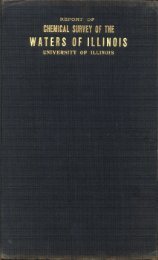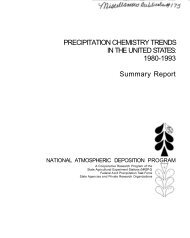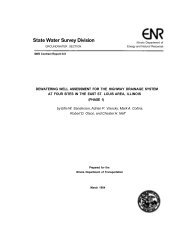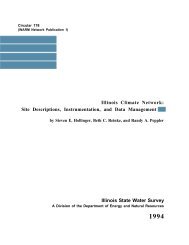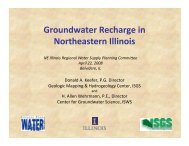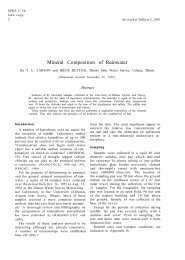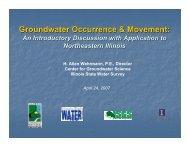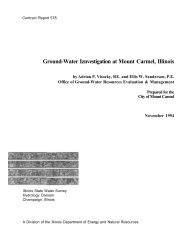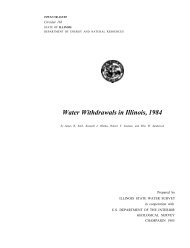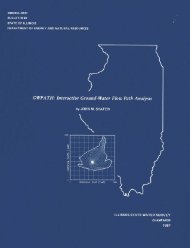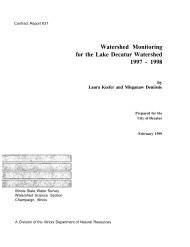Evaluation methods for detecting coliforms and fecal streptococci in ...
Evaluation methods for detecting coliforms and fecal streptococci in ...
Evaluation methods for detecting coliforms and fecal streptococci in ...
Create successful ePaper yourself
Turn your PDF publications into a flip-book with our unique Google optimized e-Paper software.
REPORT OF INVESTIGATION 78<br />
<strong>Evaluation</strong> of Methods<br />
<strong>for</strong> Detect<strong>in</strong>g Coli<strong>for</strong>ms <strong>and</strong> Fecal Streptococci<br />
<strong>in</strong> Chlor<strong>in</strong>ated Sewage Effluents<br />
by S. D. LIN<br />
TITLE: <strong>Evaluation</strong> of Methods <strong>for</strong> Detect<strong>in</strong>g Coli<strong>for</strong>ms <strong>and</strong> Fecal Streptococci <strong>in</strong> Chlor<strong>in</strong>ated<br />
Sewage Effluents<br />
ABSTRACT: Total coli<strong>for</strong>m (TC), <strong>fecal</strong> coli<strong>for</strong>m (FC), <strong>and</strong> <strong>fecal</strong> streptococcus (FS) recoveries<br />
<strong>in</strong> chlor<strong>in</strong>ated secondary sewage effluents were <strong>in</strong>vestigated by the membrane filter (MF) <strong>and</strong><br />
multiple-tube (most probable number, MPN) <strong>methods</strong>. The LES two-step MF method was found<br />
to be comparable to the MPN procedure <strong>for</strong> determ<strong>in</strong><strong>in</strong>g TC. The TC detection was 1.5 times<br />
greater by the LES two-step technique than that obta<strong>in</strong>ed by the M-Endo one-step MF procedure.<br />
Fecal coli<strong>for</strong>m recovery by the M-FC MF procedure was lower than the recovery obta<strong>in</strong>ed by the<br />
MPN method. Azide-dextrose broth, bra<strong>in</strong>-heart <strong>in</strong>fusion broth, <strong>and</strong> peptone yeast-extract casitone<br />
used separately with the M-Enterococcus agar MF 2 (2-day <strong>in</strong>cubation) procedure were not<br />
satisfactory <strong>for</strong> the recovery of FS. The M-Enterococcus agar procedure with bile broth enrichment<br />
(MF 2 ) or prolonged <strong>in</strong>cubation <strong>for</strong> 3 days (MF 3 ) significantly <strong>in</strong>creased FS recovery <strong>and</strong> both<br />
were comparable to the MPN method. The results cited should be useful <strong>in</strong> assess<strong>in</strong>g the efficiency<br />
of dis<strong>in</strong>fection practices <strong>for</strong> waste treatment plants employ<strong>in</strong>g effluent chlor<strong>in</strong>ation.<br />
REFERENCE: L<strong>in</strong>, S. D. <strong>Evaluation</strong> of Methods <strong>for</strong> Detect<strong>in</strong>g Coli<strong>for</strong>ms <strong>and</strong> Fecal Streptococci<br />
<strong>in</strong> Chlor<strong>in</strong>ated Sewage Effluents. Ill<strong>in</strong>ois State Water Survey, Urbana, Report of Investigation 78,<br />
1974.<br />
INDEXING TERMS: bacteria, chlor<strong>in</strong>ation, enrichment procedure, environmental eng<strong>in</strong>eer<strong>in</strong>g,<br />
<strong>fecal</strong> coli<strong>for</strong>ms, <strong>fecal</strong> <strong>streptococci</strong>, MF <strong>and</strong> MPN <strong>methods</strong>, prolonged <strong>in</strong>cubation, sanitary eng<strong>in</strong>eer<strong>in</strong>g,<br />
secondary sewage effluents, total coli<strong>for</strong>ms, water pollution.
STATE OF ILLINOIS<br />
HON. DANIEL WALKER, Governor<br />
DEPARTMENT OF REGISTRATION AND EDUCATION<br />
RONALD E. STACKLER, J.D., Director<br />
BOARD OF NATURAL RESOURCES AND CONSERVATION<br />
Ronald E. Stackler, J.D., Chairman<br />
Robert H. Anderson, B.S., Eng<strong>in</strong>eer<strong>in</strong>g<br />
Thomas Park, Ph.D., Biology<br />
Charles E. Olmsted, Ph.D., Botany<br />
Laurence L. Sloss, Ph.D., Geology<br />
H. S. Gutowsky, Ph.D., Chemistry<br />
William L. Everitt, E.E., Ph.D.,<br />
University of Ill<strong>in</strong>ois<br />
Elbert H. Hadley, Ph.D.,<br />
Southern Ill<strong>in</strong>ois University<br />
STATE WATER SURVEY DIVISION<br />
WILLIAM C. ACKERMANN, D.Sc, Chief<br />
URBANA<br />
1974<br />
Pr<strong>in</strong>ted by authority of the State of Ill<strong>in</strong>ois-Ch. 127, IRS, Par. 58.29<br />
(10-74-1500)
CONTENTS<br />
PAGE<br />
Summary <strong>and</strong> conclusions 1<br />
Introduction 1<br />
Literature review 1<br />
Indicator organisms 1<br />
Total coli<strong>for</strong>ms 2<br />
Fecal coli<strong>for</strong>ms 2<br />
Fecal <strong>streptococci</strong> 2<br />
Bacteria enumeration 3<br />
Objectives <strong>and</strong> report plan 4<br />
Acknowledgments 4<br />
Materials <strong>and</strong> <strong>methods</strong> 4<br />
Results <strong>and</strong> discussion 5<br />
Total coli<strong>for</strong>ms 5<br />
Fecal coli<strong>for</strong>ms 9<br />
Fecal <strong>streptococci</strong> 10<br />
References 16<br />
Appendix A. Procedures of two-step enrichment <strong>for</strong> bacterial assay 18<br />
Appendix B. Comparison of total coli<strong>for</strong>m densities determ<strong>in</strong>ed by the LES<br />
M-Endo agar two-step MF <strong>and</strong> completed MPN <strong>methods</strong> 19<br />
Appendix C. Comparison of <strong>fecal</strong> coli<strong>for</strong>m densities determ<strong>in</strong>ed by the M-FC<br />
MF method <strong>and</strong> the EC MPN procedure 20<br />
Appendix D. Comparison of <strong>fecal</strong> <strong>streptococci</strong> densities determ<strong>in</strong>ed by the<br />
st<strong>and</strong>ard MPN method <strong>and</strong> the M-Enterococcus MF method with 2, 3,4,<br />
<strong>and</strong> 7 days <strong>in</strong>cubation on chlor<strong>in</strong>ated <strong>and</strong> unchlor<strong>in</strong>ated secondary sewage<br />
effluents 21
<strong>Evaluation</strong> of Methods <strong>for</strong> Detect<strong>in</strong>g Coli<strong>for</strong>ms <strong>and</strong><br />
Fecal Streptococci <strong>in</strong> Chlor<strong>in</strong>ated Sewage Effluents<br />
by S. D. L<strong>in</strong><br />
SUMMARY AND CONCLUSIONS<br />
Two series of laboratory assays were per<strong>for</strong>med to determ<strong>in</strong>e whether or not the results with<br />
the st<strong>and</strong>ard membrane filter (MF) procedure <strong>for</strong> total coli<strong>for</strong>m, <strong>fecal</strong> coli<strong>for</strong>m, <strong>and</strong> <strong>fecal</strong> streptococcus<br />
detections on chlor<strong>in</strong>ated secondary sewage effluents were comparable to those obta<strong>in</strong>ed by the multiple-tube<br />
(MPN) method.. If not found to be the case, ef<strong>for</strong>ts were made to improve bacteria recoveries<br />
by various modifications of the MF method.<br />
Grab samples of secondary effluents were collected from three Ill<strong>in</strong>ois treatment plants. They<br />
were chlor<strong>in</strong>ated with as much as 6 mg/1 of chlor<strong>in</strong>e, stirred, <strong>and</strong> dechlor<strong>in</strong>ated by sodium thiosulfate.<br />
After vary<strong>in</strong>g periods of contact, the samples were assayed <strong>for</strong> bacteria. On the basis of the results<br />
derived from this work, the follow<strong>in</strong>g conclusions were drawn.<br />
For chlor<strong>in</strong>ated secondary sewage effluents, the recoveries of TC, FC, <strong>and</strong> FS by the st<strong>and</strong>ard<br />
MF (one-step nonenrichment) method are significantly less than those obta<strong>in</strong>ed by the st<strong>and</strong>ard MPN<br />
procedure.<br />
The use of the LES two-step MF method is comparable to the completed MPN procedures <strong>for</strong><br />
total coli<strong>for</strong>m detection. Total coli<strong>for</strong>m recovery by the LES two-step MF technique is approximately<br />
1.5 times that obta<strong>in</strong>ed us<strong>in</strong>g the M-Endo, one-step MF procedure. From 273 filters with the use of<br />
the LES two-step MF procedure <strong>and</strong> 1110 sheen colonies, 89.6 percent were verified as coli<strong>for</strong>m<br />
organisms.<br />
Estimates of MPN FC densities may be derived from the MF procedure by use of a mathematical<br />
relationship similar to log MPN = 1.06 log MF — 0.01. For FC verification, 87.7 percent of 616<br />
blue colonies were verified.<br />
Azide-dextrose broth, bra<strong>in</strong>-heart <strong>in</strong>fusion broth, <strong>and</strong> peptone yeast-extract casitone used separately<br />
<strong>for</strong> enrichment purposes with the M-Enterococcus agar MF 2 procedure did not satisfactorily <strong>in</strong>crease<br />
the sensitivity of the procedure <strong>for</strong> FS assays. Enrichment with bile broth medium of the M-<br />
Enterococcus agar MF 2 procedure significantly <strong>in</strong>creases the FS recovery to the extent that the procedure<br />
is comparable to the multiple-tube method.<br />
The recovery of FS by the membrane filter technique with M-Enterococcus agar <strong>in</strong>creased<br />
signific<strong>and</strong>y after 3 days <strong>in</strong>cubation (MF 3 ) compared with 2 days <strong>in</strong>cubation (MF,), <strong>and</strong> the MF 3<br />
procedure is comparable to the multiple-tube method <strong>for</strong> FS detection. The membrane filter technique<br />
preferred <strong>for</strong> FS assays is the MF 2 procedure us<strong>in</strong>g M-Enterococcus agar with bile broth enrichment.<br />
All of 688 colonies <strong>for</strong> 2-day <strong>in</strong>cubation on filters were verified as <strong>fecal</strong> <strong>streptococci</strong>.<br />
INTRODUCTION<br />
The year-round dis<strong>in</strong>fection of wastewater treatment<br />
plant effluents has become m<strong>and</strong>atory <strong>in</strong> Ill<strong>in</strong>ois <strong>and</strong> <strong>in</strong><br />
several other states.<br />
The most common method of dis<strong>in</strong>fection<br />
at treatment plants is chlor<strong>in</strong>ation.<br />
Its effectiveness<br />
has generally been measured by residual chlor<strong>in</strong>e. The<br />
Ill<strong>in</strong>ois Pollution Control Board 1 requires a limitation on<br />
<strong>fecal</strong> coli<strong>for</strong>m (FC) densities <strong>in</strong>dependent of residual chlor<strong>in</strong>e<br />
thus requir<strong>in</strong>g determ<strong>in</strong>ations <strong>for</strong> FC densities <strong>in</strong> chlor<strong>in</strong>ated<br />
effluents.<br />
The Board's rules stipulate that <strong>fecal</strong><br />
coli<strong>for</strong>m densities <strong>in</strong> a waste effluent shall not exceed 400<br />
per 100 milliliters (ml).<br />
Total coli<strong>for</strong>ms (TC) have been used <strong>for</strong> measur<strong>in</strong>g the<br />
dis<strong>in</strong>fection efficiencies of water <strong>and</strong> wastewater treatment<br />
units. The TC <strong>in</strong>dex is still valid <strong>and</strong> reliable <strong>for</strong> the water<br />
<strong>in</strong>dustry. In European countries <strong>fecal</strong> <strong>streptococci</strong> (FS) are<br />
commonly looked <strong>for</strong> <strong>in</strong> the sanitary analysis of water supplies.<br />
2 In the United States, they are used currently <strong>in</strong><br />
conjunction with FC <strong>for</strong> determ<strong>in</strong><strong>in</strong>g the sanitary quality of<br />
water. Although FS determ<strong>in</strong>ations are not required by<br />
most regulatory agencies, the usefulness of the procedure<br />
should not be overlooked.<br />
The requirement <strong>for</strong> bacteria enumeration <strong>in</strong> treated<br />
effluents necessitates the development of adequate <strong>and</strong><br />
economical procedures <strong>for</strong> determ<strong>in</strong><strong>in</strong>g bacteria densities <strong>in</strong><br />
chlor<strong>in</strong>ated effluents. The series of <strong>in</strong>vestigations described<br />
<strong>in</strong> this report were undertaken with that objective <strong>in</strong> m<strong>in</strong>d.<br />
Literature Review<br />
Indicator Organisms. The purpose of the rout<strong>in</strong>e bacteriological<br />
exam<strong>in</strong>ation of water samples is usually to estimate<br />
the hazard due to <strong>fecal</strong> pollution <strong>and</strong> the probability<br />
1
of the presence of pathogenic organisms. The isolation of<br />
pathogens from water <strong>and</strong> sewage is expensive <strong>and</strong> laborious.<br />
It is not a rout<strong>in</strong>e practice. Normally occurr<strong>in</strong>g bacteria<br />
<strong>in</strong> the <strong>in</strong>test<strong>in</strong>es of warm-blooded animals have been<br />
used as <strong>in</strong>dicators of <strong>fecal</strong> pollution. Total coli<strong>for</strong>ms, <strong>fecal</strong><br />
coli<strong>for</strong>ms, <strong>and</strong> <strong>fecal</strong> <strong>streptococci</strong> have all been used as pollution<br />
<strong>in</strong>dicators at various times. 3 ' 4 Other bacterial <strong>in</strong>dicators<br />
have been proposed <strong>in</strong>clud<strong>in</strong>g Closteridium, Pseudomonas,<br />
<strong>and</strong> Aerobacter, but their value has been considered<br />
questionable or irrelevant. 5<br />
Correlations between coli<strong>for</strong>ms <strong>and</strong> pathogenic bacteria<br />
have been cited frequently, i.e., coli<strong>for</strong>ms vs Salmonella. 6,7,8,9<br />
Less known is the relationship, if any exists, between coli<strong>for</strong>ms<br />
<strong>and</strong> viruses. A coli<strong>for</strong>m <strong>in</strong>dex is not a reliable <strong>in</strong>dex<br />
<strong>for</strong> viruses. 10,11 There is little evidence that enteroviral or<br />
other microbial diseases are transmitted frequently by the<br />
dr<strong>in</strong>k<strong>in</strong>g water route <strong>in</strong> the absence of coli<strong>for</strong>ms. 5<br />
Until more def<strong>in</strong>itive studies are completed on the relationship<br />
of pathogens <strong>and</strong> <strong>in</strong>dicator organisms, the use of TC<br />
<strong>for</strong> water supplies <strong>and</strong> FC <strong>and</strong> FS <strong>for</strong> sewage <strong>and</strong> stream<br />
quality, as <strong>in</strong>dicators of enteric pollution, is valid.<br />
Total Coli<strong>for</strong>ms. Total coli<strong>for</strong>m densities have been used<br />
to measure the occurrence <strong>and</strong> degree of <strong>fecal</strong> pollution <strong>in</strong><br />
streams <strong>for</strong> over 60 years. As def<strong>in</strong>ed <strong>in</strong> St<strong>and</strong>ard Methods, 4<br />
"the coli<strong>for</strong>m group comprises all of the aerobic <strong>and</strong> facultative<br />
anaerobic, gram-negative, nonspore-<strong>for</strong>m<strong>in</strong>g, rod-shaped<br />
bacteria which ferment lactose with gas <strong>for</strong>mation with<strong>in</strong><br />
48 hr at 35°C."<br />
The TC group has been adopted as an <strong>in</strong>dicator of <strong>fecal</strong><br />
pollution suggestive of a hazard to health because these bacteria<br />
are associated with the gut of warm-blooded animals.<br />
Thus, the absence of TC is generally evidence of a bacteriologically<br />
safe water.<br />
The TC group can be subgrouped as <strong>fecal</strong> <strong>and</strong> non<strong>fecal</strong><br />
coli<strong>for</strong>ms. The <strong>fecal</strong> coli<strong>for</strong>m subgroup is derived from<br />
feces of human <strong>and</strong> other warm-blooded animals such as<br />
cows, sheep, poultry, etc. The other (non<strong>fecal</strong>) subgroup<br />
is frequently found on vegetation <strong>and</strong> <strong>in</strong> the soil; some are<br />
plant pathogens. Organisms of the non<strong>fecal</strong> subgroup tend<br />
to survive longer <strong>in</strong> water than do the <strong>fecal</strong> subgroup. The<br />
non<strong>fecal</strong> coli<strong>for</strong>ms also tend to be somewhat more resistant<br />
to chlor<strong>in</strong>ation than the FC group or the commonly occurr<strong>in</strong>g<br />
<strong>in</strong>test<strong>in</strong>al bacterial pathogens. 12 The aftergrowth of<br />
TC organisms is generally associated with the Aerobacter<br />
aerogenes portion of the non<strong>fecal</strong> subgroup. 13 ' 14 There<strong>for</strong>e<br />
the sanitary significances of these two subgroups are different.<br />
The presence of FC organisms <strong>in</strong>dicates recent, <strong>and</strong><br />
possibly hazardous, <strong>fecal</strong> pollution. The presence of non<strong>fecal</strong><br />
coli<strong>for</strong>ms suggests less recent pollution or reveals<br />
defects <strong>in</strong> water treatment or distribution systems. 3<br />
Fecal Coli<strong>for</strong>ms. If the hypothesis that the coli<strong>for</strong>m bacteria<br />
of <strong>fecal</strong> orig<strong>in</strong> represent greater danger to health than<br />
those native to other environments is accepted, the separation<br />
of the <strong>fecal</strong> <strong>and</strong> non<strong>fecal</strong> groups is necessary. Enu-<br />
merat<strong>in</strong>g <strong>methods</strong> <strong>for</strong> FC by the elevated temperature tests<br />
have been developed by Geldreich et al. <strong>for</strong> the MPN procedure<br />
15 <strong>and</strong> <strong>for</strong> the MF technique. 16 The MF technique with<br />
the FC medium is an acceptable procedure listed <strong>in</strong> the 13 th<br />
edition of St<strong>and</strong>ard Methods. 4 It detects not only E. coli<br />
but other coli<strong>for</strong>m types that are derived from warm-blooded<br />
animal feces.<br />
The most common <strong>fecal</strong> coli<strong>for</strong>m species is Escherichia<br />
coli. The FC organisms generally do not multiply outside<br />
the <strong>in</strong>test<strong>in</strong>es of warm-blooded animals, except <strong>in</strong> certa<strong>in</strong><br />
high-carbohydrate wastewaters such as that from sugar beet<br />
ref<strong>in</strong>eries. 5 Populations <strong>and</strong> types vary from host species to<br />
host species, <strong>and</strong> even accord<strong>in</strong>g to the <strong>in</strong>dividual. 17<br />
In domestic sewage, the FC density may constitute 30 to<br />
40 percent of the TC density. In aged sewage <strong>and</strong> <strong>in</strong> polluted<br />
waters, the FC fraction tends to decrease progressively<br />
with elapsed time. In heavily polluted surface waters, the<br />
FC component usually falls between 10 <strong>and</strong> 35 percent of<br />
the TC count. 3 In natural waters, relatively free from recent<br />
pollution by enteric wastes, the FC count is unlikely<br />
to exceed 10 percent of the TC count. There are, however,<br />
too many variables relat<strong>in</strong>g to enteric pollution, runoff water,<br />
<strong>and</strong> natural water quality, to permit a sweep<strong>in</strong>g generalization<br />
on the numerical relationships between FC <strong>and</strong> TC.<br />
Fecal Streptococci. The <strong>fecal</strong> <strong>streptococci</strong> group, as<br />
stated <strong>in</strong> St<strong>and</strong>ard Methods, 4 is restricted to the follow<strong>in</strong>g<br />
species, or their varieties: S. faecalis, S. faecalis var. liquefaciens,<br />
S. faecalis var. zymogenes, S. durans, S. faecium,<br />
S. bovis, <strong>and</strong> S. equ<strong>in</strong>us. The 'enterococcus' refers to a<br />
more restrictive group, <strong>in</strong>clud<strong>in</strong>g all the above species except<br />
S. bovis <strong>and</strong> S. equ<strong>in</strong>us. The terms '<strong>fecal</strong> streptococcus' <strong>and</strong><br />
'Lancefield's Group D streptococcus' are considered synonymous.<br />
In the present state of knowledge, a precise def<strong>in</strong>ition of<br />
<strong>fecal</strong> <strong>streptococci</strong> is not possible. The United K<strong>in</strong>gdom<br />
M<strong>in</strong>istry of Health def<strong>in</strong>es these organisms as "gram-positive<br />
cocci, generally occurr<strong>in</strong>g <strong>in</strong> pairs or short cha<strong>in</strong>s, grow<strong>in</strong>g<br />
<strong>in</strong> the presence of bile salt, usually capable of development<br />
at 45°C, produc<strong>in</strong>g acid but not gas <strong>in</strong> mannitol <strong>and</strong> lactose,<br />
fail<strong>in</strong>g to attack raff<strong>in</strong>ose, fail<strong>in</strong>g to reduce nitrate to nitrite,<br />
produc<strong>in</strong>g acid <strong>in</strong> litmus milk <strong>and</strong> precipitat<strong>in</strong>g the case<strong>in</strong><br />
<strong>in</strong> the <strong>for</strong>m of a loose but solid curd, <strong>and</strong> exhibit<strong>in</strong>g a<br />
greater resistance to heat, to alkal<strong>in</strong>e conditions <strong>and</strong> to high<br />
concentrations of salt than most vegetative bacteria." 5 However,<br />
it is po<strong>in</strong>ted out that "<strong>streptococci</strong> depart<strong>in</strong>g <strong>in</strong> one or<br />
more particulars from the type species cannot be disregarded<br />
<strong>in</strong> water." Some workers consider that growth at 45 C <strong>and</strong><br />
multiplication <strong>in</strong> 40 percent bile broth are the most significant<br />
<strong>in</strong>dications of <strong>fecal</strong> orig<strong>in</strong> of <strong>streptococci</strong>.<br />
Fecal <strong>streptococci</strong> are nonpathogenic organisms. Nevertheless<br />
their common occurrence <strong>in</strong> the <strong>in</strong>test<strong>in</strong>es of man <strong>and</strong><br />
other warm-blooded animals makes them a useful group as<br />
an <strong>in</strong>dicator of <strong>fecal</strong> contam<strong>in</strong>ation. They also have been<br />
considered <strong>in</strong>dicators of <strong>fecal</strong> pollution <strong>for</strong> nearly 60<br />
2
years. 18 ' 19 Their poor acceptance as a pollution <strong>in</strong>dicator<br />
is due to low recovery rates, the multiplicity of detection<br />
procedures, poor agreement between various enumeration<br />
<strong>methods</strong>, <strong>and</strong> the lack of detailed <strong>and</strong> systematic studies of<br />
the sources, survival, <strong>and</strong> <strong>in</strong>terpretation of FS <strong>in</strong> various<br />
k<strong>in</strong>ds of water. On the basis of more recent studies the FS<br />
will become an additional <strong>in</strong>dicator particularly valuable <strong>for</strong><br />
stream studies.<br />
Bartley <strong>and</strong> Slanetz 20 reported that organisms produc<strong>in</strong>g<br />
large maroon colored colonies on membranes are usually<br />
the tellurite resistant 5. faecalis types of FS, <strong>and</strong> the small<br />
p<strong>in</strong>k colonies are usually tellurite sensitive S. bovis types.<br />
The confirmation of these can be made by Gram sta<strong>in</strong> <strong>and</strong><br />
appropriate culture tests. At least 80 percent of FS from<br />
human orig<strong>in</strong> is of the S. faecalis groups. The major groups<br />
found <strong>in</strong> the feces of most domestic animals, especially<br />
cows <strong>and</strong> sheep, are S. bovis <strong>and</strong> 5. equ<strong>in</strong>us. 17,21 This<br />
diversity <strong>in</strong> group<strong>in</strong>g, dependent upon source, permits reasonable<br />
estimates of the sources (animal versus human) of<br />
<strong>fecal</strong> contam<strong>in</strong>ation <strong>in</strong> water. FS will not multiply <strong>in</strong> water<br />
but some species may survive <strong>in</strong> unfavorable conditions.<br />
Their die-off rate is uncerta<strong>in</strong> at this time. 17<br />
Studies 22 have <strong>in</strong>dicated the concentration of FS <strong>in</strong><br />
feces to be of the same order of magnitude as that of con<strong>for</strong>ms.<br />
The isolation <strong>and</strong> enumeration procedures satisfactory<br />
<strong>for</strong> rout<strong>in</strong>e laboratory tests are available. On the<br />
basis of these advantages, the Committee on Public Health<br />
Activities of the American Society of Civil Eng<strong>in</strong>eers 22 concluded<br />
that the use of FS is superior to coli<strong>for</strong>m organisms<br />
as pollution <strong>in</strong>dicators.<br />
Geldreich et al. 23 first suggested the use of an FC to FS<br />
ratio as a more valuable <strong>in</strong><strong>for</strong>mational tool <strong>for</strong> assess<strong>in</strong>g<br />
pollution sources than the use solely of FC densities. In<br />
apply<strong>in</strong>g the ratio concept to a natural stream system, stream<br />
samples not more than 24 hours downstream of a pollution<br />
source must be used. Ratios greater than 4:1 <strong>in</strong>dicate the<br />
pollution source is likely to be derived from domestic wastewaters,<br />
whereas ratios less than 0.7:1 suggest the bacteria<br />
are from sources other than human, i.e., livestock <strong>and</strong> poultry<br />
wastes. 14 ' 24 With these considerations <strong>in</strong> m<strong>in</strong>d, together<br />
with other suggested <strong>in</strong>terpretations <strong>for</strong> <strong>in</strong>termediate values,<br />
17 FS determ<strong>in</strong>ations can be an important tool <strong>for</strong> a<br />
stream study.<br />
Although there has not been any def<strong>in</strong>itive work reported<br />
on FC:FS ratios <strong>for</strong> chlor<strong>in</strong>ated sewage effluents, some prelim<strong>in</strong>ary<br />
results 25 suggest that FS organisms might be more<br />
resistant to chlor<strong>in</strong>ation than FC types. On unchlor<strong>in</strong>ated<br />
effluents the FC:FS ratio was found to average 11.2:1 <strong>for</strong><br />
18 samples; on chlor<strong>in</strong>ated effluents the ratio averaged<br />
0.72:1 <strong>for</strong> 63 samples.<br />
Bacteria Enumeration. The basic <strong>methods</strong> <strong>for</strong> the assay<br />
of pollution <strong>in</strong>dicators (TC, FC, <strong>and</strong> FS) <strong>in</strong> waters are outl<strong>in</strong>ed<br />
<strong>in</strong> St<strong>and</strong>ard Methods. 4 These <strong>in</strong>clude the multiple-tube<br />
or most probable number (MPN) technique <strong>and</strong> the membrane<br />
filter (MF) procedure. St<strong>and</strong>ard Methods, however,<br />
states that "Experience <strong>in</strong>dicates that the MF procedure is<br />
applicable to the exam<strong>in</strong>ation of sal<strong>in</strong>e waters but not chlor<strong>in</strong>ated<br />
wastewaters." Because the MF technique is comparable<br />
to the MPN procedure <strong>and</strong> is less time consum<strong>in</strong>g,<br />
it seems un<strong>for</strong>tunate that the MF technique cannot be used<br />
as a control procedure by the waste plant operator who uses<br />
chlor<strong>in</strong>ation.<br />
McKee et al. 26 reported on the lack of correlation between<br />
MPN <strong>and</strong> MF techniques while assay<strong>in</strong>g chlor<strong>in</strong>ated<br />
settled wastewater <strong>for</strong> total coli<strong>for</strong>ms. Because monochloram<strong>in</strong>e<br />
is the predom<strong>in</strong>ant bactericidal agent <strong>in</strong> chlor<strong>in</strong>ated<br />
wastes, they advanced the hypothesis that partial<br />
reversibility is responsible <strong>for</strong> the discrepancy between<br />
MPN <strong>and</strong> MF results; that is, the MF technique produces<br />
considerably fewer colonies than the number that develop<br />
by the MPN method. Presumably, when <strong>in</strong>activated cells<br />
are deposited on a membrane with limited nutrient availability,<br />
the cells cannot rid themselves of monochloram<strong>in</strong>e <strong>and</strong><br />
there<strong>for</strong>e cannot grow. However, when <strong>in</strong>activated cells are<br />
put <strong>in</strong> an aqueous medium rich <strong>in</strong> organic matter, such as<br />
lactose broth, the monochloram<strong>in</strong>e may diffuse outwardly<br />
from the cells, permitt<strong>in</strong>g them to recover, grow, <strong>and</strong> produce<br />
gas.<br />
In the McKee et al. 26 ' 27 <strong>in</strong>vestigations, dehydrated<br />
scheduled nutrient (DSN) pads were used <strong>for</strong> the MF technique.<br />
They conta<strong>in</strong>ed two elements with an upper leaf<br />
impregnated with an Endo-type <strong>in</strong>hibitory nutrient. The<br />
results obta<strong>in</strong>ed from the use of DSN pads with the MF<br />
technique were comparable to those obta<strong>in</strong>ed from the confirmed<br />
MPN procedures on raw settled wastewater. McCarthy<br />
et al., 28 though work<strong>in</strong>g <strong>in</strong>itially with water, were not satisfied<br />
with the one-step, M-Endo broth MF techniques.<br />
Their work suggested that enrichment plus an agar substrate<br />
was superior to the one-step technique on the basis of a<br />
higher degree of coli<strong>for</strong>m recovery. Exam<strong>in</strong>ations of natural<br />
waters <strong>and</strong> wastewater demonstrated that these results<br />
were comparable to st<strong>and</strong>ard MPN data. From their work an<br />
agar-based medium (LES M-Endo agar) was developed. Its<br />
use with the MF technique is basically a two-step enrichment<br />
procedure.<br />
The need has developed not only <strong>for</strong> determ<strong>in</strong><strong>in</strong>g total<br />
coli<strong>for</strong>ms but also <strong>for</strong> enumerat<strong>in</strong>g <strong>fecal</strong> coli<strong>for</strong>m densities.<br />
Geldreich et al. 16 recommended the use of an M-FC medium<br />
at <strong>in</strong>cubation temperatures of 44.5 ±0.5 C as part of the<br />
MF technique <strong>for</strong> the direct count of <strong>fecal</strong> coli<strong>for</strong>ms. It has<br />
been reported 29 ' 30 ' 31 that the determ<strong>in</strong>ations <strong>for</strong> <strong>fecal</strong> coli<strong>for</strong>ms<br />
rather than total coli<strong>for</strong>ms are a more realistic measurement<br />
of the public health significance of microbial discharges<br />
<strong>in</strong> wastewater plants. Ill<strong>in</strong>ois requirements specify<br />
maximum permissible limits <strong>for</strong> <strong>fecal</strong> coli<strong>for</strong>m concentrations<br />
<strong>in</strong> treated effluents. This will require <strong>fecal</strong> coli<strong>for</strong>m<br />
enumeration <strong>in</strong> chlor<strong>in</strong>ated effluents.<br />
Lattanzi <strong>and</strong> Mood 32 used the W<strong>in</strong>ter <strong>and</strong> S<strong>and</strong>holzer<br />
3
method <strong>for</strong> the detection of enterococci. Later Litsky et<br />
al. 33 suggested the use of glucose azide broth as a presumptive<br />
medium <strong>and</strong> ethyl violet azide (EVA) broth as a confirmatory<br />
medium <strong>for</strong> enterococci detection with MPN<br />
procedures.<br />
Slanetz <strong>and</strong> Bartley 34 proposed the use of M-Enterococcus<br />
agar <strong>for</strong> the isolation of FS by the MF method. Kenner<br />
et al. 35 <strong>in</strong>troduced the KF streptococcus agar. Rose <strong>and</strong><br />
Litsky 36 found they could <strong>in</strong>crease the recovery of FS from<br />
river water by more than 2-fold when us<strong>in</strong>g peptone yeastextract<br />
casitone (PYC) compared with M-Enterococcus agar.<br />
Recently Pavlova et al. 37 suggested that fluorescent antibody<br />
techniques may be useful <strong>for</strong> FS detection, <strong>in</strong> determ<strong>in</strong><strong>in</strong>g<br />
the presence <strong>and</strong> source of <strong>fecal</strong> pollution <strong>in</strong> water.<br />
Objectives <strong>and</strong> Report Plan<br />
Dur<strong>in</strong>g this study two separate <strong>in</strong>vestigations were per<strong>for</strong>med.<br />
One dealt pr<strong>in</strong>cipally with TC <strong>and</strong> FC, the other<br />
with FS. The purposes of the study were:<br />
1) To determ<strong>in</strong>e whether or not the MF technique <strong>for</strong><br />
TC, FC, <strong>and</strong> FS detections <strong>in</strong> chlor<strong>in</strong>ated secondary<br />
effluents is comparable to the MPN method.<br />
2) To determ<strong>in</strong>e whether or not the LES two-step enrichment<br />
MF technique <strong>for</strong> TC detection, <strong>in</strong> chlor<strong>in</strong>ated<br />
secondary effluents, is comparable to recommended<br />
MPN methodology.<br />
3) To develop improvements <strong>in</strong> the MF method <strong>for</strong><br />
the detection of FS <strong>in</strong> chlor<strong>in</strong>ated secondary sewage<br />
effluents.<br />
This report describes the procedures used. It also <strong>in</strong>cludes<br />
the results obta<strong>in</strong>ed <strong>and</strong> a discussion <strong>for</strong> each of the bacterial<br />
groups exam<strong>in</strong>ed, i.e., TC, FC, <strong>and</strong> FS. The two-step<br />
enrichment MF method is described <strong>in</strong> appendix A. Included<br />
<strong>in</strong> appendices B, C, <strong>and</strong> D are tabulations of observed data<br />
<strong>for</strong> TC, FC, <strong>and</strong> FS, respectively.<br />
Acknowledgments<br />
The study was conducted under the general supervision<br />
of Ralph L. Evans, Head of the Water Quality Section, <strong>and</strong><br />
Dr. William C. Ackermann, Chief, Ill<strong>in</strong>ois State Water Survey.<br />
A special expression of gratitude is extended to Dorothea<br />
Seiz, Microbiologist, Ill<strong>in</strong>ois Department of Public Health,<br />
Spr<strong>in</strong>gfield, <strong>for</strong> her valuable advice. Many Water Survey<br />
personnel assisted <strong>in</strong> the study. Davis B. Beuscher, Jack W.<br />
Williams, Pamella A. Mart<strong>in</strong>, Donald H. Schnepper,. <strong>and</strong><br />
Larry G. Epley assisted <strong>in</strong> laboratory <strong>and</strong> sampl<strong>in</strong>g dur<strong>in</strong>g<br />
this study. Mrs. J. Loreena Ivens, Technical Editor, edited<br />
the f<strong>in</strong>al report; Mrs. Suzi O'Connor prepared the cameraready<br />
copy; Miss Kather<strong>in</strong>e Shemas, Clerk Typist, typed the<br />
orig<strong>in</strong>al manuscript; <strong>and</strong> John Brother, Jr., Chief Draftsman,<br />
prepared the illustrations.<br />
MATERIALS AND METHODS<br />
Grab samples of f<strong>in</strong>al settl<strong>in</strong>g tank effluents from three<br />
wastewater treatment plants serv<strong>in</strong>g the cities of Peoria,<br />
Morton, <strong>and</strong> Wash<strong>in</strong>gton <strong>in</strong> Ill<strong>in</strong>ois were used <strong>in</strong> the study.<br />
At least five effluent samples from each plant were exam<strong>in</strong>ed.<br />
The Peoria plant employs the high-rate activated sludge process<br />
treat<strong>in</strong>g a comb<strong>in</strong>ation of domestic <strong>and</strong> <strong>in</strong>dustrial<br />
wastewaters. Contact stabilization comparable to the st<strong>and</strong>ard-rate<br />
activated sludge process is used at Morton. This<br />
plant treats pr<strong>in</strong>cipally domestic wastewater. Wash<strong>in</strong>gton is<br />
served by a st<strong>and</strong>ard-rate trickl<strong>in</strong>g filter plant, treat<strong>in</strong>g domestic<br />
wastewater also.<br />
One-liter portions of each effluent were dosed with calcium<br />
hypochlorite (HTH, 70 percent available chlor<strong>in</strong>e) up<br />
through 6 mg/1 of chlor<strong>in</strong>e. The samples were stirred gently<br />
but <strong>in</strong>termittently, <strong>and</strong> after vary<strong>in</strong>g periods of contact (up<br />
to 30 m<strong>in</strong>utes) they were dechlor<strong>in</strong>ated with an excess of<br />
sodium thiosulfate. The dechlor<strong>in</strong>ated samples were assayed<br />
immediately <strong>for</strong> bacterial densities by parallel MPN <strong>and</strong> MF<br />
<strong>methods</strong>.<br />
The MPN procedures were per<strong>for</strong>med by us<strong>in</strong>g a series of<br />
four decimal dilutions per sample, with five tubes <strong>for</strong> each<br />
dilution. Lauryl tryptose (LT) broth was used <strong>for</strong> the presumptive<br />
tests <strong>in</strong> TC <strong>and</strong> FC determ<strong>in</strong>ations. The TC test<br />
was confirmed with the use of brilliant green bile (BGB)<br />
medium, <strong>and</strong> was completed with Gram sta<strong>in</strong>. For FC confirmation,<br />
an EC medium at 44.5 ±0.5 C (water bath) was<br />
used. In the MPN procedure <strong>for</strong> FS tests, azide-dextrose<br />
(AD) broth was used <strong>for</strong> the presumptive test, while ethyl<br />
violet azide broth was used <strong>for</strong> confirmation.<br />
In the MF procedures <strong>for</strong> TC, FC, <strong>and</strong> FS, three duplications<br />
<strong>for</strong> each sample were filtered through an 0.45M membrane<br />
filter <strong>for</strong> each bacteria test. For TC tests, the twostep<br />
enrichment of LES M-Endo agar 28 was followed.<br />
Occasionally, parallel tests with the st<strong>and</strong>ard one-step M-<br />
Endo procedure were per<strong>for</strong>med. For TC verification purposes,<br />
representative colonies (3 to 6 sheen colonies per<br />
filter) were subcultured through LT broth <strong>in</strong>to BGB broth. 38<br />
Production of gas on BGB broth was deemed verification.<br />
When us<strong>in</strong>g MF procedures <strong>for</strong> FC detections, the recommendations<br />
of Geldreich et al. 16 were followed. Several<br />
colonies (3 to 6 blue colonies per filter) placed on a filter<br />
<strong>and</strong> <strong>in</strong>cubated onto the M-FC medium were verified by <strong>in</strong>-<br />
4
oculat<strong>in</strong>g <strong>in</strong> phenol red lactose broth <strong>for</strong> a 24- to 48-hour<br />
period at 35°C <strong>and</strong> not<strong>in</strong>g gas production. All positive tubes<br />
were confirmed at 44.5 C <strong>in</strong> EC broth.<br />
In the determ<strong>in</strong>ation of FS densities by the MF technique,<br />
the st<strong>and</strong>ard one-step M-Enterococcus agar 4 was used.<br />
Accord<strong>in</strong>g to Seiz 39 M-Enterococcus agar is superior to KF<br />
streptococcus agar, <strong>for</strong> sewage effluents because some of the<br />
non<strong>streptococci</strong> species <strong>in</strong> sewage samples grow red <strong>and</strong><br />
p<strong>in</strong>k colonies on KF streptococcus agar. The FS counts on<br />
the membrane filters were generally made after 2, 3, 4, <strong>and</strong><br />
7 days <strong>in</strong>cubation. Parallel tests with the two-step enrichment<br />
(appendix A) were also per<strong>for</strong>med. The enrichment<br />
media used <strong>in</strong>clude AD broth, bra<strong>in</strong>-heart <strong>in</strong>fusion (BHI)<br />
broth, bile broth medium (prepared by add<strong>in</strong>g 40 ml sterile<br />
10 percent oxgall solution to 60 ml sterile BHI broth), <strong>and</strong><br />
PYC broth. The period of the pre-enrichment was 2 to 3<br />
hours. For the purpose of FS verification, red <strong>and</strong> p<strong>in</strong>k<br />
colonies (3 to 6 colonies per filter) were fished at r<strong>and</strong>om<br />
from the membrane filter <strong>and</strong> <strong>in</strong>oculated onto a bra<strong>in</strong>-heart<br />
<strong>in</strong>fusion agar (BHIA) slant, followed by a catalase test. If<br />
the catalase test was negative, then the growth on the BHIA<br />
slant was subcultured <strong>in</strong>to both a BHI broth <strong>and</strong> a bile broth<br />
medium <strong>for</strong> confirmation.<br />
With slight variation all bacterial assay procedures followed<br />
St<strong>and</strong>ard Methods. 4 Generally, all the media used<br />
were freshly prepared, <strong>and</strong> none was more than 4 days old.<br />
RESULTS AND DISCUSSION<br />
Total Coli<strong>for</strong>ms<br />
Multiple-Tube versus Membrane Filter. Consistent with<br />
St<strong>and</strong>ard Methods 4 recommendations that a comparison be<br />
made between MPN <strong>and</strong> MF techniques be<strong>for</strong>e us<strong>in</strong>g the MF<br />
procedure, a series of bacterial assays on unchlor<strong>in</strong>ated<br />
samples from a variety of sources was per<strong>for</strong>med. This<br />
evaluation <strong>in</strong>cluded enumeration <strong>for</strong> total coli<strong>for</strong>ms as well<br />
as <strong>fecal</strong> coli<strong>for</strong>ms. Table 1 summarizes the results. Results<br />
of the paired data t-test technique <strong>in</strong> test<strong>in</strong>g the hypothesis<br />
(H 0 ) that the mean of the first population is equal to the<br />
mean of the second (tests 1 <strong>and</strong> 3 of table 9) did not <strong>in</strong>dicate<br />
significant differences <strong>in</strong> TC <strong>and</strong> FC recoveries determ<strong>in</strong>ed<br />
by the MPN <strong>and</strong> MF <strong>methods</strong>. The comparisons <strong>for</strong><br />
the purposes of this study, there<strong>for</strong>e, were considered<br />
acceptable.<br />
M-Endo {one-step) versus LES M-Endo (two-step). Samples<br />
of chlor<strong>in</strong>ated effluents from an activated sludge process<br />
were evaluated <strong>for</strong> TC densities by M-Endo one-step <strong>and</strong><br />
LES M-Endo agar two-step MF procedures. McCarthy et<br />
al. 28 per<strong>for</strong>med a similar assessment on unchlor<strong>in</strong>ated water<br />
samples from rivers, lakes, <strong>and</strong> ponds lead<strong>in</strong>g to the development<br />
of the LES agar-based medium. The results obta<strong>in</strong>ed<br />
on chlor<strong>in</strong>ated secondary effluents were comparable<br />
to those observed by McCarthy et al. 28 As shown <strong>in</strong> figure<br />
1, the plotted data lie above the equality l<strong>in</strong>e, <strong>in</strong>dicat<strong>in</strong>g<br />
that total coli<strong>for</strong>m recovery by the LES two-step procedure<br />
was superior to the M-Endo one-step method. A better development<br />
of sheen colonies was also observed on the LES<br />
medium.<br />
The experiences of McCarthy et al. 28 <strong>and</strong> McKee et al. 26<br />
were similar with regard to total coli<strong>for</strong>m recovery from unchlor<strong>in</strong>ated<br />
wastewater samples. The McCarthy group found<br />
no advantage <strong>in</strong> us<strong>in</strong>g an enrichment phase when compared<br />
Table 1. Comparison of the MPN <strong>and</strong> the MF Coli<strong>for</strong>m<br />
Densities of Unchlor<strong>in</strong>ated Waters<br />
(Densities per 100 ml)<br />
with a one-step agar method on unchlor<strong>in</strong>ated wastes <strong>and</strong><br />
polluted waters. They suggested that the recovery efficiency<br />
<strong>for</strong> total coli<strong>for</strong>ms was a function of the number of coli<strong>for</strong>ms<br />
<strong>in</strong> the sample. There<strong>for</strong>e, <strong>in</strong> natural waters where<br />
smaller numbers of coli<strong>for</strong>ms are likely to exist, an enrichment<br />
phase <strong>in</strong> the MF technique is required, whereas with<br />
polluted waters <strong>and</strong> unchlor<strong>in</strong>ated wastewater, the enrichment<br />
two-step procedure can be omitted without significant<br />
5
Figure 1. Comparison of TC counts made on M-Endo broth<br />
<strong>and</strong> on LES M-Endo agar<br />
effect on coli<strong>for</strong>m recovery. McKee <strong>and</strong> his colleagues<br />
experienced the lessen<strong>in</strong>g of coli<strong>for</strong>m recovery on chlor<strong>in</strong>ated<br />
settled wastewater similar to that described <strong>for</strong> water with<br />
a smaller number of coli<strong>for</strong>ms. This suggests that equivalent<br />
conditions are encountered when temporarily <strong>in</strong>activated<br />
colonies exist or a smaller number of colonies are present.<br />
In both cases, an enrichment phase would more than likely<br />
be required to atta<strong>in</strong> satisfactory coli<strong>for</strong>m recovery with the<br />
MF technique.<br />
Although the number of colonies per filter as depicted <strong>in</strong><br />
figure 1 exceeded the desirable range of 20 to 80 per filter,<br />
they were considered satisfactory <strong>for</strong> comparison purposes.<br />
The results correlated well (r = 0.968), <strong>and</strong> the relationship<br />
between the two procedures can be expressed as<br />
<strong>in</strong>ed. Figure 2 represents observations of the LES two-step<br />
MF technique, <strong>and</strong> figure 3 represents observations of the<br />
multiple-tube procedure. The figures reflect simply the<br />
geometric distribution of the bacterial densities <strong>for</strong> all<br />
effluents as determ<strong>in</strong>ed by the two techniques. Similar<br />
curves could have been presented <strong>for</strong> each type of effluent.<br />
More important <strong>for</strong> comparative purposes is the summary<br />
<strong>in</strong>cluded <strong>in</strong> table 2. For the MF technique, <strong>in</strong>clud<strong>in</strong>g all data,<br />
the geometric mean (M ) was 29,000 total coli<strong>for</strong>ms/100 ml;<br />
the geometric st<strong>and</strong>ard deviation (σ g<br />
) was 12.14; <strong>and</strong> the<br />
arithmetic mean computed from geometric parameters 40<br />
was 650,000/100 ml. Similarly, the MPN data reflected a<br />
geometric mean of 28,000 coli<strong>for</strong>ms/100 ml, a geometric<br />
st<strong>and</strong>ard deviation of 13.55, <strong>and</strong> an arithmetic mean of<br />
700,000/100 ml. All of the data, <strong>in</strong>clud<strong>in</strong>g that <strong>for</strong> each<br />
type of effluent summarized <strong>in</strong> table 2, suggest that the<br />
LES two-step MF method <strong>for</strong> chlor<strong>in</strong>ated effluents is comparable<br />
<strong>in</strong> coli<strong>for</strong>m recovery efficiency to the multiple-tube<br />
procedure.<br />
Figure 4 is a graphical presentation <strong>for</strong> comparative purposes<br />
also. For the 71 samples exam<strong>in</strong>ed, 32 of the MF results<br />
are higher <strong>and</strong> 34 of the MF results are lower than concurrent<br />
MPN results. Five observations were found to be<br />
identical. The ratios of MF:MPN varied from 0.44 to 5.03<br />
with a median of 1.00. The mathematical relationship between<br />
the two procedures observed dur<strong>in</strong>g this study was<br />
with a correlation coefficient of 0.99.<br />
As shown <strong>in</strong> test 2 of table 9 the TC recovered by the<br />
MPN <strong>and</strong> LES M-Endo MF <strong>methods</strong> are not significantly<br />
different. It is concluded that the LES two-step MF technique<br />
was as good as the multiple-tube method <strong>for</strong> assay<strong>in</strong>g<br />
total coli<strong>for</strong>m densities <strong>in</strong> chlor<strong>in</strong>ated secondary effluents.<br />
From the st<strong>and</strong>po<strong>in</strong>t of time, convenience, freedom from<br />
bias, <strong>and</strong> equipment needs, the LES two-step technique<br />
would seem preferable to the multiple-tube technique <strong>for</strong><br />
chlor<strong>in</strong>ated effluents.<br />
where TC 1<br />
<strong>and</strong> TC 2<br />
are, respectively, the total coli<strong>for</strong>m<br />
colonies determ<strong>in</strong>ed by the one-step <strong>and</strong> two-step MF techniques.<br />
The total coli<strong>for</strong>m recovery on chlor<strong>in</strong>ated effluents<br />
by the LES two-step procedure is about 1.5 times greater<br />
than that atta<strong>in</strong>ed by the M-Endo one-step method.<br />
LES (two-step) versus Multiple-Tube. The multiple-tube<br />
method is considered acceptable <strong>for</strong> assay<strong>in</strong>g the total coli<strong>for</strong>m<br />
densities <strong>in</strong> chlor<strong>in</strong>ated wastewater effluents. A comparison<br />
of the total coli<strong>for</strong>m data result<strong>in</strong>g from the LES<br />
two-step method, which was used <strong>in</strong> this study, with bacterial<br />
densities obta<strong>in</strong>ed from parallel multiple-tube observations<br />
was there<strong>for</strong>e pert<strong>in</strong>ent. Methods described by<br />
Thomas 40<br />
were used <strong>in</strong> figures 2 <strong>and</strong> 3 to depict the total<br />
coli<strong>for</strong>m data <strong>for</strong> all chlor<strong>in</strong>ated secondary effluents exam-<br />
Table 2. Comparative Results <strong>for</strong> Total Coli<strong>for</strong>m Data<br />
(Total coli<strong>for</strong>ms per 100 ml)<br />
6
Figure 2. TC analysis by LES two-step MF membrane filter technique on samples of chlor<strong>in</strong>ated effluents<br />
7
Figure 3. Total coli<strong>for</strong>m MPN analysis of chlor<strong>in</strong>ated effluents
LES (two-step) <strong>and</strong> Multiple-Tube Verifications. Occasionally,<br />
coli<strong>for</strong>m bacteria may fail to produce colonies on<br />
membrane filters; noncon<strong>for</strong>m organisms may develop sheen<br />
colonies. Verification procedures were undertaken <strong>for</strong> coli<strong>for</strong>m<br />
organisms on all membrane <strong>and</strong> multiple-tube samples<br />
<strong>in</strong> accordance with procedures described by Geldreich<br />
et al. 38 The results are summarized <strong>in</strong> table 3. From 273<br />
membrane filters, 1110 sheen colonies were selected <strong>for</strong><br />
verification; 89.6 percent were verified as coli<strong>for</strong>m organisms.<br />
Trickl<strong>in</strong>g filter effluent displayed the highest verification<br />
(97.5 percent) from the MF technique. It was also<br />
the highest (93.3 percent) <strong>in</strong> us<strong>in</strong>g the MPN procedure.<br />
From 97 MPN samples verifications ranged from 22 to 100<br />
percent; however, 80 percent of the MPN samples reflected<br />
100 percent verification. The average verifications <strong>for</strong> both<br />
the MF <strong>and</strong> MPN <strong>methods</strong> were higher than those reported<br />
by Geldreich et al., 38 which were 78.1 percent <strong>for</strong> MF <strong>and</strong><br />
70.3 percent <strong>for</strong> MPN on samples of natural waters <strong>and</strong><br />
sewages.<br />
Time Effect after Dechlor<strong>in</strong>ation. Dur<strong>in</strong>g the course of<br />
the <strong>in</strong>vestigation, the question arose as to whether or not,<br />
after the dechlor<strong>in</strong>ation of samples, the observed bacterial<br />
densities significantly fluctuated with time. This seemed an<br />
important consideration because of the time element <strong>in</strong>volved<br />
<strong>in</strong> per<strong>for</strong>m<strong>in</strong>g comparative techniques. For this <strong>in</strong>vestigation,<br />
samples of three types of secondary effluent were<br />
chlor<strong>in</strong>ated at vary<strong>in</strong>g dosages <strong>for</strong> a contact time of 15 m<strong>in</strong>utes<br />
after which they were dechlor<strong>in</strong>ated as previously<br />
described <strong>and</strong> kept at room temperature (20 to 22°C). Bacterial<br />
density assays were undertaken with the LES two-step<br />
<strong>and</strong> the multiple-tube <strong>methods</strong> at 15-m<strong>in</strong>ute <strong>in</strong>tervals <strong>for</strong> a<br />
2-hour period. The procedure not only permitted an assessment<br />
of the time element but also provided an opportunity<br />
<strong>for</strong> additional comparative analysis of the MF versus MPN<br />
techniques. The results are summarized <strong>in</strong> table 4.<br />
There was no significant change <strong>in</strong> coli<strong>for</strong>m densities<br />
dur<strong>in</strong>g the more than 2-hour period. A comparison of the<br />
paired MF <strong>and</strong> MPN results <strong>in</strong>dicates the <strong>in</strong>herent precision<br />
of the MF method over that of the MPN.<br />
Fecal Coli<strong>for</strong>ms<br />
Comparisons <strong>for</strong> assay<strong>in</strong>g <strong>fecal</strong> coli<strong>for</strong>ms were made with<br />
the M-FC MF technique recommended by Geldreich et al. 16<br />
<strong>and</strong> the confirmed MPN procedures. 4 These procedures<br />
have been accepted <strong>for</strong> <strong>fecal</strong> coli<strong>for</strong>m enumerations on unchlor<strong>in</strong>ated<br />
wastewater. Four chlor<strong>in</strong>ated effluents were<br />
exam<strong>in</strong>ed. One effluent, representative of the Bloom<strong>in</strong>gton-<br />
Normal, Ill<strong>in</strong>ois, sanitary district's activated sludge process,<br />
was collected from a chlor<strong>in</strong>e contact tank effluent stream<br />
<strong>and</strong> immediately dechlor<strong>in</strong>ated; the other three were treated<br />
with various dosages of chlor<strong>in</strong>e as previously described.<br />
The results of the two assay <strong>methods</strong> on the four effluents<br />
are shown <strong>in</strong> figure 5. It is apparent that most of the plotted<br />
Figure 4. LES two-step MF <strong>and</strong> complete MPN results on<br />
chlor<strong>in</strong>ated effluents<br />
po<strong>in</strong>ts lie below the l<strong>in</strong>e of equality. In fact, 78 are below,<br />
12 are above, <strong>and</strong> 6 are on the l<strong>in</strong>e. Adjust<strong>in</strong>g the equality<br />
l<strong>in</strong>e <strong>for</strong> MPN bias as described by Thomas 40 does little to<br />
change the pattern; 74 po<strong>in</strong>ts are below <strong>and</strong> 22 are above<br />
the l<strong>in</strong>e. In several cases the discrepancy is by a factor of<br />
10 or more which is not apparent <strong>in</strong> figure 5.<br />
It can be concluded that the M-FC MF technique <strong>for</strong><br />
<strong>fecal</strong> coli<strong>for</strong>m detection, when applied to chlor<strong>in</strong>ated wastewater<br />
effluents, is less efficient <strong>in</strong> recovery than the confirmed<br />
MPN procedure. It is suggested that an enrichment<br />
step similar to that used <strong>in</strong> the LES two-step procedure <strong>for</strong><br />
total coli<strong>for</strong>ms might improve the recovery efficiency, <strong>and</strong><br />
further <strong>in</strong>vestigations seem justified.<br />
The m<strong>in</strong>imum <strong>and</strong> maximum <strong>fecal</strong> coli<strong>for</strong>m ratios of<br />
MF/MPN <strong>for</strong> all tests were 0.17 <strong>and</strong> 1.46, respectively. The<br />
median ratio was 0.70. On the basis of observations from<br />
Table 3. Validity of Two-Step MF <strong>and</strong> Confirmed MPN Tests<br />
9
Table 4. Comparison of Total Coli<strong>for</strong>m Density (per 100 ml)<br />
<strong>in</strong> Effluents after Dechlor<strong>in</strong>ation Detected by MF<br />
<strong>and</strong> MPN Techniques<br />
96 comparative runs, the relationship of <strong>fecal</strong> coli<strong>for</strong>m<br />
densities <strong>in</strong> chlor<strong>in</strong>ated effluents <strong>for</strong> the two procedures<br />
can be expressed as<br />
The correlation coefficient is 0.99. Until a more precise<br />
procedure is developed <strong>for</strong> us<strong>in</strong>g MF techniques, <strong>in</strong> recover<strong>in</strong>g<br />
<strong>fecal</strong> coli<strong>for</strong>ms from chlor<strong>in</strong>ated wastewater, a mathematical<br />
expression of this nature may be useful <strong>for</strong> estimat<strong>in</strong>g<br />
MPN densities. The results should be multiplied by the<br />
factor 0.851 as described by Thomas 40 <strong>for</strong> an estimate<br />
without bias.<br />
Verification of membrane-developed colonies was made<br />
with phenol-red lactose broth <strong>and</strong> EC broth. A total of 616<br />
blue colonies were fished <strong>for</strong> verification; 87.7 percent were<br />
verified. This was lower than the 93.2 percent verification<br />
reported by Geldreich 29 on pure cultures. .<br />
Fecal Streptococci<br />
Multiple-Tube versus Membrane Filter. For comparison<br />
of the MPN <strong>and</strong> MF techniques a series of FS tests on unchlor<strong>in</strong>ated<br />
samples from a variety of sources were per<strong>for</strong>med.<br />
The results are summarized <strong>in</strong> table 5. A statistical<br />
test of the observed data was made with the t-test of pair<strong>in</strong>g<br />
observations to determ<strong>in</strong>e whether there is a significant<br />
difference <strong>in</strong> FS recoveries by the MPN <strong>and</strong> MF 2 <strong>methods</strong>.<br />
The results <strong>in</strong>dicate there is no statistical difference <strong>in</strong> the<br />
mean values of the bacterial counts determ<strong>in</strong>ed by the two<br />
<strong>methods</strong> (test 4 of table 9). The FS densities obta<strong>in</strong>ed from<br />
both procedures are comparable <strong>and</strong> probably have the same<br />
sanitary significance. There<strong>for</strong>e the laboratory techniques<br />
of this study were considered acceptable.<br />
One hundred <strong>and</strong> thirty-one chlor<strong>in</strong>ated samples taken<br />
from three secondary sewage effluents were concurrently<br />
assayed <strong>for</strong> FS densities by the MPN <strong>and</strong> MF procedures.<br />
The colonies developed on the membrane filter that were<br />
counted after 2, 3,4, <strong>and</strong> 7 days <strong>in</strong>cubation were designated<br />
MF 2 , MF 3 , MF 4 , <strong>and</strong> MF 7 , respectively. The MF 2 or MPN<br />
method is recommended by St<strong>and</strong>ard Methods. 4<br />
The comparative results of MF 2 <strong>and</strong> MPN on chlor<strong>in</strong>ated<br />
samples are presented graphically <strong>in</strong> figure 6. It is<br />
apparent that most of the plotted po<strong>in</strong>ts lie below the l<strong>in</strong>e<br />
of equality. In fact, 107 plotted po<strong>in</strong>ts are below, 19 are<br />
above, <strong>and</strong> 5 are on the l<strong>in</strong>e. From adjust<strong>in</strong>g the equality<br />
l<strong>in</strong>e <strong>for</strong> the MPN bias, as described by Thomas, 40 most of<br />
the plotted po<strong>in</strong>ts (97 po<strong>in</strong>ts) are below the MPN bias<br />
reference l<strong>in</strong>e, 32 po<strong>in</strong>ts are above, <strong>and</strong> 2 are on the l<strong>in</strong>e.<br />
Statistically significant differences were found <strong>in</strong> FS recoveries,<br />
when compar<strong>in</strong>g the MPN procedure with the MF 2<br />
10
Table 5. Most Probable Number <strong>and</strong> Membrane Filter<br />
Fecal Streptococci per 100 ml<br />
<strong>in</strong> Unchlor<strong>in</strong>ated Waters<br />
Figure 5. FC densities determ<strong>in</strong>ed by MF <strong>and</strong> MPN<br />
techniques on chlor<strong>in</strong>ated effluents<br />
ment <strong>for</strong> chlor<strong>in</strong>ated samples are shown <strong>in</strong> figures 7, 8, <strong>and</strong><br />
9. All FS counts <strong>in</strong> these figures were made after 2-day <strong>in</strong>cubation.<br />
Although the number of colonies per filter as<br />
depicted <strong>in</strong> these figures exceeded the desirable range of 20<br />
to 100 per filter, they were considered satisfactory <strong>for</strong> comparison<br />
purposes.<br />
method (test 5 of table 9). It can be concluded that the MF 2<br />
procedure gives lower FS recovery on chlor<strong>in</strong>ated effluents<br />
than does the MPN procedure. It seemed reasonable that enrichment<br />
<strong>and</strong> prolonged <strong>in</strong>cubation might improve FS recovery<br />
with the MF method.<br />
Enrichment. Azide-dextrose broth is the medium used<br />
<strong>for</strong> the presumptive test of the MPN method <strong>for</strong> <strong>fecal</strong> <strong>streptococci</strong><br />
<strong>in</strong> waters. Bra<strong>in</strong>-heart <strong>in</strong>fusion broth <strong>and</strong> bile broth<br />
medium are the confirmation media of FS <strong>for</strong> the MF method.<br />
These three media were used <strong>in</strong> this study <strong>for</strong> enrichment<br />
purposes <strong>in</strong> ef<strong>for</strong>ts to enhance FS recovery <strong>in</strong> chlor<strong>in</strong>ated<br />
effluents. The results of FS recovery on M-<br />
Enterococcus agars (MF method) with <strong>and</strong> without enrich-<br />
Figure 6. FS densities determ<strong>in</strong>ed by one-step MF <strong>and</strong> MPN<br />
techniques on chlor<strong>in</strong>ated effluents<br />
11
Figure 7. Comparison of FS counts on M-Enterococcus<br />
agars with <strong>and</strong> without azide-dextrose<br />
broth enrichment<br />
With AD broth enrichment, all plotted po<strong>in</strong>ts lie below<br />
the equality l<strong>in</strong>e (figure 7). In other words, the FS recovery<br />
from chlor<strong>in</strong>ated effluent on M-Enterococcus agars with<br />
AD broth enrichment falls far short of that without enrichment.<br />
This is substantiated by the t-test (test 6 of table 9)<br />
<strong>and</strong> it is concluded that enrichment with AD broth <strong>in</strong>hibits<br />
the FS recovery of chlor<strong>in</strong>ated samples on membranes.<br />
Figure 8. Comparison of FS counts on M-Enterococcus<br />
agars with <strong>and</strong> without bra<strong>in</strong>-heart <strong>in</strong>fusion<br />
broth enrichment<br />
Figure 8 shows no appreciable difference <strong>in</strong> FS counts<br />
with or without BHI broth enrichment. Eleven plotted<br />
po<strong>in</strong>ts lie above, 9 lie below, <strong>and</strong> 5 po<strong>in</strong>ts are on the equality<br />
l<strong>in</strong>e. A statistical test (test 7 of table 9) suggests no significant<br />
difference <strong>in</strong> FS recoveries from chlor<strong>in</strong>ated effluents<br />
determ<strong>in</strong>ed by the MF method with or without enrichment.<br />
With the least square regression technique, the plotted po<strong>in</strong>ts<br />
<strong>in</strong> figure 8 can be fitted as follows:<br />
12<br />
Figure 9. Comparison of FS counts on M-Enterococcus<br />
agars with <strong>and</strong> without bile broth enrichment<br />
<strong>in</strong> which Y = FS counts by M-Enterococcus agar MF 2<br />
with BHI broth enrichment, <strong>in</strong> organisms per 100 ml;<br />
X = FS counts by one-step M-Enterococcus agar MF 2 method,<br />
<strong>in</strong> organisms per 100 ml. The correlation coefficient is<br />
0.97. Equation 4 shows the slope to be 0.97 with an <strong>in</strong>tercept<br />
of 0.097. Thus the regression l<strong>in</strong>e expressed by equation<br />
4 is almost identical with a 45-degree l<strong>in</strong>e. From these<br />
tests, it can be reasonably concluded there is no advantage<br />
to BHI broth enrichment <strong>for</strong> the MF method on chlor<strong>in</strong>ated<br />
effluent samples.<br />
It is quite evident from the data depicted <strong>in</strong> figure 9 that<br />
the FS recovery with bile broth enrichment is higher than<br />
FS recovery by nonenrichment techniques. Fifty-three comparisons<br />
were made on three effluents <strong>and</strong> only two effluent<br />
samples showed the enrichment FS counts slightly less than<br />
the nonenrichment. This is confirmed by statistical analyses<br />
(test 8 of table 9). It is concluded that bile broth enrichment<br />
did improve FS recovery on chlor<strong>in</strong>ated effluent samples.<br />
A peptone yeast-extract casitone enrichment broth was<br />
suggested by Rose <strong>and</strong> Litsky 36 <strong>for</strong> use with the MF method<br />
<strong>for</strong> the enrichment of FS recovery <strong>in</strong> unchlor<strong>in</strong>ated wa-
ters. To determ<strong>in</strong>e the efficiency of the PYC broth on chlor<strong>in</strong>ated<br />
effluent samples, parallel tests were made with<br />
PYC broth, bile broth medium, <strong>and</strong> without enrichment on<br />
portions of the same samples.<br />
About one-half of the experimental results were discarded<br />
because of extremely high or low counts. The results (68<br />
samples) where filter counts were <strong>in</strong> the desirable range of<br />
20 to 100 are summarized <strong>in</strong> table 6. The values <strong>in</strong> table 6<br />
represent a 2-day <strong>in</strong>cubation period. For all tested effluents,<br />
with few exceptions, the recovery of ES <strong>in</strong>creased with enrichment,<br />
<strong>and</strong> especially with bile broth enrichment.<br />
The recovery ratios of enrichment to nonenrichment <strong>for</strong><br />
each effluent are presented <strong>in</strong> table 7. The highest average<br />
ratios were 2.45:1 <strong>and</strong> 1.77:1 <strong>for</strong> bile broth <strong>and</strong> PYC enrichment,<br />
respectively. Similarly, the overall average ratios<br />
<strong>for</strong> the 68 samples were 2.14:1 <strong>and</strong> 1.60:1. The recovery<br />
ratio of PYC enrichment to nonenrichment <strong>for</strong> chlor<strong>in</strong>ated<br />
samples was much less than the 2.44:1 ratio <strong>for</strong> unchlor<strong>in</strong>ated<br />
waters reported by Rose <strong>and</strong> Litsky. 36<br />
N<strong>in</strong>eteen chlor<strong>in</strong>ated samples were exam<strong>in</strong>ed <strong>for</strong> FS densities<br />
by both MPN <strong>and</strong> PYC enrichment MF <strong>methods</strong>. The<br />
results from these assays are depicted <strong>in</strong> figure 10. The<br />
equality l<strong>in</strong>e was adjusted <strong>for</strong> MPN bias as described by<br />
Thomas <strong>and</strong> used <strong>for</strong> reference. Fourteen plotted po<strong>in</strong>ts<br />
lie below the equality l<strong>in</strong>e, 4 are above, <strong>and</strong> 1 is on the l<strong>in</strong>e.<br />
A t-test analysis confirmed the differences (test 9 of table<br />
9). From this test it is concluded that the recovery of FS<br />
from chlor<strong>in</strong>ated effluents on PYC enriched membrane filters<br />
is less than that <strong>for</strong> the MPN procedure. Although<br />
prolonged <strong>in</strong>cubation through 7 days on PYC enriched filters<br />
showed <strong>in</strong>creas<strong>in</strong>g counts with time, no attempt was<br />
made to compare prolonged PYC enriched MF counts with<br />
MPN values.<br />
Bile broth enrichment, as mentioned earlier, gave the<br />
highest recovery of FS from chlor<strong>in</strong>ated effluent samples.<br />
To compare the bile broth enriched MF 2 results with the<br />
MPN data, 45 chlor<strong>in</strong>ated samples collected from three sewage<br />
effluents were subjected to FS assays, <strong>in</strong> parallel, by<br />
both <strong>methods</strong>. The results of the analyses are presented <strong>in</strong><br />
figure 11. The ratios of the bile enriched MF 2 to the MPN<br />
FS densities were calculated, arrayed <strong>in</strong> order of magnitude,<br />
<strong>and</strong> plotted on log-probability paper. The l<strong>in</strong>e of the best<br />
fit was drawn. The median, or 50 percentile of the 45 ratios<br />
is 1.00. In fact, 4 ratios are equal to, 21 are greater than, <strong>and</strong><br />
20 ratios are less than unity. This <strong>in</strong>dicates that the bile enriched<br />
MF 2 data are <strong>in</strong> very close agreement with the data<br />
obta<strong>in</strong>ed by MPN techniques. It was also observed that there<br />
was no significant <strong>in</strong>crease <strong>in</strong> FS count on the bile enriched<br />
filters <strong>for</strong> prolonged <strong>in</strong>cubation up through 7 days. It is concluded<br />
that the bile enrichment MF 2 method is superior to<br />
the PYC enrichment MF 2 method <strong>and</strong> comparable to<br />
the MPN procedure <strong>for</strong> the recovery of FS <strong>in</strong> chlor<strong>in</strong>ated<br />
sewage effluents.<br />
Prolonged Incubation.' As stated earlier, the M-Enterococcus<br />
agar MF 2 (nonenriched) technique tends to produce<br />
Table 6. Comparison of Recovery of Fecal Streptococci<br />
on M-Enterococcus Agars with <strong>and</strong> without Enrichment<br />
* Incubation time was 48 hours <strong>for</strong> all cases; NE means without<br />
enrichment on M-Enterococcus agar; PYC means with PYC<br />
broth enrichment; <strong>and</strong> bile means with bile broth enrichment.<br />
lower FS recovery than the MPN procedure on chlor<strong>in</strong>ated<br />
effluents (see figure 6). Colonies developed <strong>for</strong> 2-day <strong>in</strong>cubation<br />
were generally small. To check the effects of prolonged<br />
<strong>in</strong>cubation on FS recovery <strong>for</strong> the M-Enterococcus<br />
agar MF technique all filters were counted at the end of 2,<br />
3, 4, <strong>and</strong> 7 days <strong>in</strong>cubation. Figure 12, a typical example,<br />
shows the general trend of the FS counts with <strong>in</strong>cubation<br />
time. The FS recovery <strong>in</strong>creased significantly up through<br />
the 3-day period. After 3 days, the FS counts leveled off<br />
Table 7. FS Recovery Ratios of Enrichment<br />
to Nonenrichment<br />
13
Figure 10. Comparison of FS densities determ<strong>in</strong>ed by the<br />
MPN <strong>and</strong> the PYC enrichment MF <strong>methods</strong><br />
Figure 12. Recovery of FS on M-Enterococcus agar from<br />
one unchlor<strong>in</strong>ated <strong>and</strong> three chlor<strong>in</strong>ated secondary effluents<br />
Figure 11. Analysis of FS recovery made on chlor<strong>in</strong>ated<br />
effluents by the use of multiple-tube (MPN) test<br />
<strong>and</strong> M-Enterococcus agar MF with bile broth enrichment<br />
14<br />
Table 8. Fecal Streptococci Count MF 3 /MF 2 Ratio<br />
<strong>for</strong> chlor<strong>in</strong>ated effluents. For the unchlor<strong>in</strong>ated effluent<br />
sample, no significant <strong>in</strong>crease was found <strong>in</strong> FS counts after<br />
a 2-day <strong>in</strong>cubation. The ratios of MF 3 to MF 2 <strong>for</strong> unchlor<strong>in</strong>ated<br />
<strong>and</strong> chlor<strong>in</strong>ated effluents are summarized <strong>in</strong> table 8.<br />
For chlor<strong>in</strong>ated samples the average MF 3 /MF 2 ranged from<br />
a low of 1.27 <strong>for</strong> contact stabilization effluent, to a high of<br />
2.12 <strong>for</strong> high-rate activated sludge with an overall average of<br />
1.84.<br />
Figure 13 depicts 124 comparisons of the nonenriched<br />
MF 3 data with the MPN results on three chlor<strong>in</strong>ated effluents.<br />
Seventy-six plotted po<strong>in</strong>ts are above the l<strong>in</strong>e of<br />
equality, <strong>and</strong> 38 are below. With the corrected MPN bias as<br />
a reference l<strong>in</strong>e, 101 po<strong>in</strong>ts are above, 21 are below, <strong>and</strong> 2<br />
are on the l<strong>in</strong>e. The MF 3 results were found to be slightly<br />
higher than the MPN data, especially when the FS counts<br />
were less than 500/100 ml (figure 13). For the 124 <strong>in</strong>stances,<br />
the geometric mean values were 1300 MF 3 /100 ml<br />
<strong>and</strong> 1100 MPN/ 100 ml. The geometric st<strong>and</strong>ard deviations<br />
were 3.98 <strong>and</strong> 4.93 <strong>for</strong> the MF 3 <strong>and</strong> the MPN <strong>methods</strong>,<br />
respectively. However, a statistical test (test 10 of table 9)<br />
did not <strong>in</strong>dicate a significant difference between the MPN<br />
<strong>and</strong> MF 3 <strong>methods</strong>.<br />
When compar<strong>in</strong>g MF 3 <strong>and</strong> MPN results <strong>for</strong> 124 chlor<strong>in</strong>ated<br />
effluent samples <strong>in</strong> a manner similar to that depicted
Table 9. Results of the t-test <strong>for</strong> Significance of Difference between<br />
Paired Observations<br />
<strong>in</strong> figure 11, the median, or 50 percentile, <strong>for</strong> the MF /MPN<br />
is 1.11. Although the MF 3 values are slightly higher than<br />
the MPN data, the MF procedure <strong>for</strong> 3-day <strong>in</strong>cubation on<br />
M-Enterococcus agar, without enrichment, appears applicable<br />
<strong>for</strong> the FS assay of chlor<strong>in</strong>ated effluents.<br />
Verification. Altogether 967 colonies were fished from<br />
306 membrane filters <strong>and</strong> subjected to the verification procedure<br />
outl<strong>in</strong>ed <strong>in</strong> St<strong>and</strong>ard Methods 4 The results of the<br />
verification are summarized <strong>in</strong> table 10. These <strong>in</strong>clude all<br />
colonies both with <strong>and</strong> without enrichment. After 2-day<br />
<strong>in</strong>cubation, all of 688 colonies isolated from unchlor<strong>in</strong>ated<br />
<strong>and</strong> chlor<strong>in</strong>ated effluents were verified as <strong>fecal</strong> <strong>streptococci</strong>.<br />
Although Kenneret al. 21 reported similar 100 percent<br />
recovery of FS from the membranes <strong>for</strong> the <strong>fecal</strong><br />
samples, Rose <strong>and</strong> Litsky 36 experienced a 94.6 percent FS<br />
verification from filters placed on M-Enterococcus agars<br />
with <strong>and</strong> without PYC enrichment <strong>for</strong> natural waters. From<br />
mark<strong>in</strong>gs placed on the back of petri dishes dur<strong>in</strong>g this study<br />
it was possible to dist<strong>in</strong>guish 2-, 3-, <strong>and</strong> 4-day growth colonies.<br />
About 5 to 7 percent of the 3- <strong>and</strong> 4-day growth colonies<br />
were not verified as FS (table 10).<br />
Table 10. Verification of FS Colonies<br />
Figure 13. Comparison of FS densities determ<strong>in</strong>ed by the<br />
MPN <strong>and</strong> M-Enterococcus agar MF 3 <strong>methods</strong>
REFERENCES<br />
1 Ill<strong>in</strong>ois Environmental Protection Agency. 1972.<br />
Water pollution regulations <strong>in</strong> Ill<strong>in</strong>ois. March 7.<br />
36 p.<br />
2 Stanier, R. Y., M.' Doudoroff, <strong>and</strong> E. A. Alelberg.<br />
1963. The microbial world. Prentice Hall, Inc.,<br />
Englewood Cliffs, New Jersey, p. 43.<br />
3 Kabler, P. W. 1968. Microbial considerations <strong>in</strong><br />
dr<strong>in</strong>k<strong>in</strong>g water. Journal of American Water Works<br />
Association v. 60(10):1173-1180.<br />
4 American Public Health Association, American Water<br />
Works Association, <strong>and</strong> Water Pollution Control<br />
Federation. 1971. St<strong>and</strong>ard <strong>methods</strong> <strong>for</strong> the<br />
exam<strong>in</strong>ation of water <strong>and</strong> wastewater. American<br />
Public Health Association, Inc., 13th ed., New York,<br />
875 p.<br />
5 Work<strong>in</strong>g Group of Water Quality of the Subcommittee<br />
on Water Quality, Interdepartmental Committee on<br />
Water. 1972. Guidel<strong>in</strong>es <strong>for</strong> water quality objectives<br />
<strong>and</strong> st<strong>and</strong>ards, a prelim<strong>in</strong>ary report. Department<br />
of the Environment, Ottawa, Canada, Inl<strong>and</strong><br />
Water Branch, Technical Bullet<strong>in</strong> 67, p. 14-25.<br />
6 Gallagher, T. P., <strong>and</strong> D. F. Sp<strong>in</strong>o. 1968. The significance<br />
of numbers of coli<strong>for</strong>m bacteria as an <strong>in</strong>dicator<br />
of enteric pathogens. Water Research, Pergamon<br />
Press, Great Brita<strong>in</strong> v. 2(1):169-175.<br />
7 Geldreich, E. E. 1970. Apply<strong>in</strong>g bacteriological<br />
parameters to recreational water quality. Journal<br />
of American Water Works Association v. 62(2):<br />
113-120.<br />
8 Smith, R. J., <strong>and</strong> R. M. Twedt. 1971. Natural relationships<br />
of <strong>in</strong>dicator <strong>and</strong> pathogenic bacteria <strong>in</strong><br />
stream waters. Journal of Water Pollution Control<br />
Federation v. 43(ll):2000-2209.<br />
9 Smith, R. J., R.M. Twedt, <strong>and</strong> L.K. Flanigan. 1973.<br />
Relationships of <strong>in</strong>dicator <strong>and</strong> pathogenic bacteria<br />
<strong>in</strong> stream waters. Journal of Water Pollution Con-<br />
. trol Federation v. 45(8):1736-1745.<br />
10 Committee on Environmental Quality Management of<br />
the Sanitary Eng<strong>in</strong>eer<strong>in</strong>g Division. 1970. Eng<strong>in</strong>eer<strong>in</strong>g<br />
evaluation of virus hazard <strong>in</strong> water.<br />
American Society of Civil Eng<strong>in</strong>eers, Journal of<br />
Sanitary Eng<strong>in</strong>eer<strong>in</strong>g Division v. 96(SA1):111-161.<br />
11 Geldreich, E. E., <strong>and</strong> N. A. Clarke. 1971. The coli<strong>for</strong>m<br />
test: a criterion <strong>for</strong> the viral safety of water.<br />
In Virus <strong>and</strong> Water Quality: Occurrence <strong>and</strong> Control,<br />
Proceed<strong>in</strong>gs 13 th Water Quality Conference,<br />
Department of Civil Eng<strong>in</strong>eer<strong>in</strong>g, University of<br />
Ill<strong>in</strong>ois at Urbana-Champaign, p. 103-113.<br />
12 Kabler, P. W., <strong>and</strong> H.F.Clark. 1960. Coli<strong>for</strong>m group<br />
<strong>and</strong> <strong>fecal</strong> coli<strong>for</strong>m organisms as <strong>in</strong>dicators of pollution<br />
<strong>in</strong> dr<strong>in</strong>k<strong>in</strong>g water. Journal of American Water<br />
Works Association v. 52(12):1577-1579.<br />
13 Kittrell, F. W., <strong>and</strong> S. A. Furfari. 1963. Observations<br />
of coli<strong>for</strong>m bacteria <strong>in</strong> streams. Journal of<br />
Water Pollution Control Federation v. 35(11):<br />
1361-1385.<br />
14 Geldreich, E. E. 1967. Fecal coli<strong>for</strong>m concepts <strong>in</strong><br />
stream pollution. Water & Sewage Works v. 114:<br />
R98-R109.<br />
15 Geldreich, E. E., H. F..Clark, P. W. Kabler, C. B. Huff,<br />
<strong>and</strong> R. H. Bordner. 1958. The coli<strong>for</strong>m group,<br />
II. Reactions <strong>in</strong> EC medium at 45 C. Applied<br />
Microbiology v. 6(5):347-348.<br />
16 Geldreich, E. E., H. F. Clark, C. B. Huff, <strong>and</strong> L. C.<br />
Best. 1965. Fecal-coli<strong>for</strong>m-organisms medium<br />
<strong>for</strong> the membrane filter technique. Journal of<br />
American Water Works Association v. 57(2):<br />
208-214.<br />
17 Millipore Corporation. 1972. Biological analysis of<br />
water <strong>and</strong> wastewater. Millipore Corporation, Bed<strong>for</strong>d,<br />
Mass., Application Manual AM 302, 2nd<br />
pr<strong>in</strong>t<strong>in</strong>g, p. 33-36.<br />
18 Sherman, J. M. 1937. The <strong>streptococci</strong>. Bacteriological<br />
Reviews v. l(l):3-97.<br />
19 Litsky, W., W. L. Mallmann, <strong>and</strong> C. W. Fifield. 1955.<br />
Comparison of the most probable numbers of<br />
Escherichia coli <strong>and</strong> enterococci <strong>in</strong> river waters.<br />
American Journal of Public Health v. 45(8):<br />
1049-1053.<br />
20 Bartley, C. H., <strong>and</strong> L. W. Slanetz. 1960. Types <strong>and</strong><br />
sanitary significance of <strong>fecal</strong> <strong>streptococci</strong> isolated<br />
from feces, sewage, <strong>and</strong> water. American Journal<br />
of Public Health v. 50(10):1545-1552.<br />
21 Kenner, B. A., H. F. Clark, <strong>and</strong> P. W. Kabler. 1960.<br />
. Fecal <strong>streptococci</strong>, II. Quantification of <strong>streptococci</strong><br />
<strong>in</strong> feces. American Journal of Public Health<br />
v. 50(10):1553-1559.<br />
22 Committee on Public Health Activities, ASCE. 1961.<br />
Coli<strong>for</strong>m organisms as an <strong>in</strong>dex of water safety.<br />
American Society of Civil Eng<strong>in</strong>eers, Journal of<br />
Sanitary Eng<strong>in</strong>eer<strong>in</strong>g Division v. 87(SA6):41-58.<br />
23 Geldreich, E. E., H. F. Clark, <strong>and</strong> C. B. Huff. 1964.<br />
A study of pollution <strong>in</strong>dicators <strong>in</strong> a waste stabilization<br />
pond. Journal of Water Pollution Control<br />
Federation v. 36(11):1372-1379.<br />
24 Geldreich, E. E., <strong>and</strong> B. A. Kenner. 1969. Concepts<br />
of <strong>fecal</strong> <strong>streptococci</strong> <strong>in</strong> stream pollution. Journal<br />
of Water Pollution Control Federation v. 41(8):<br />
R336-R352.<br />
25 Ill<strong>in</strong>ois State Water Survey. 1972. Unpublished<br />
data.<br />
26 McKee, J. E., R. T. McLaughl<strong>in</strong>, <strong>and</strong> P. Lesgourgues.<br />
1958. Application of molecular filter techniques<br />
to the bacteria assay of sewage. III. Effects of<br />
physical <strong>and</strong> chemical dis<strong>in</strong>fection. Sewage <strong>and</strong><br />
Industrial Wastes v. 30(3):245-252.<br />
27 McKee, J. E., <strong>and</strong> R. T. McLaughl<strong>in</strong>. 1958. Application<br />
of molecular filter techniques to the bacteria<br />
assay of sewage. II. Experimental results <strong>for</strong><br />
settled sewage. Sewage <strong>and</strong> Industrial Wastes<br />
v. 30(2):129-137.<br />
16
28 McCarthy, J. A., J. E. Delaney, <strong>and</strong> R. J. Grasso.<br />
1961. Measur<strong>in</strong>g coli<strong>for</strong>ms <strong>in</strong> water. Water &<br />
Sewage Works v. 108(6):238-243.<br />
29 Geldreich, E. E. 1966. Sanitary significance of <strong>fecal</strong><br />
coli<strong>for</strong>ms <strong>in</strong> the environments. U. S. Department<br />
of Interior, FWPCA publication WP-20-3,<br />
122 p.<br />
30 Evans, F. L. Ill, E. E. Geldreich, S. R. Weibel, <strong>and</strong> G.<br />
G. Robeck. 1968. -Treatment of urban stormwater<br />
runoff. Journal of Water Pollution Control<br />
Federation v. 48(5):R162-R170.<br />
31 ORSANCO Water Users Committee. 1971. Total<br />
coli<strong>for</strong>m: <strong>fecal</strong> coli<strong>for</strong>m ratio <strong>for</strong> evaluation of raw<br />
water bacterial quality. Journal of Water Pollution<br />
Control Federation v. 43(4):630-640.<br />
32 Lattanzi, W. E., <strong>and</strong> E. W. Mood. 1951. A.comparison<br />
of enterococci <strong>and</strong> Escherichia coli as <strong>in</strong>dices<br />
of water pollution. Sewage <strong>and</strong> Industrial Wastes<br />
v. 23(9): 1154-1160.<br />
33 Litsky, W., W. L. Mallmahn, <strong>and</strong> C. W. Fifield. 1953.<br />
A new medium <strong>for</strong> the detection of enterococci <strong>in</strong><br />
water. American Journal of Public Health v. 43(7):<br />
873-879.<br />
34 Slanetz, L. W., <strong>and</strong> C. H. Bartley. 1957. Numbers<br />
of enterococci <strong>in</strong> water, sewage <strong>and</strong> feces determ<strong>in</strong>ed<br />
by the membrane filter technique with an<br />
improved medium, Journal of Bacteriology<br />
v. 74(5):591-595.<br />
35 Kenner, B. A., H. F. Clark, <strong>and</strong> P. W. Kabler. 1961.<br />
Fecal <strong>streptococci</strong> I. Cultivation <strong>and</strong> enumeration<br />
of <strong>streptococci</strong> <strong>in</strong> surface waters. Applied Microbiology<br />
v. 9(1): 15-20.<br />
36 Rose, R. E., <strong>and</strong> W. Litsky. 1965. Enrichment procedure<br />
<strong>for</strong> use with the membrane filter <strong>for</strong> the isolation<br />
<strong>and</strong> enumeration of <strong>fecal</strong> <strong>streptococci</strong> <strong>in</strong> water.<br />
Applied Microbiology v. 13(1): 106-108.<br />
37 Pavlova, M. T., E. Beauvais, F. T. Brezenski, <strong>and</strong> W.<br />
Litsky. 1972. Rapid assessment of water quality<br />
by fluorescent antibody identification of <strong>fecal</strong><br />
<strong>streptococci</strong>. Proceed<strong>in</strong>gs of the 6th International<br />
Water Pollution Research, Pergamon Press Ltd.,<br />
London, A/3/5/1-A/3/5/8.<br />
38 Geldreich, E. E., H. L. Jeter, <strong>and</strong> J. A. W<strong>in</strong>ter. 1967.<br />
Technical considerations <strong>in</strong> apply<strong>in</strong>g the membrane<br />
filter procedure. Health Laboratory Science<br />
v. 4(2): 113-125.<br />
39 Seiz, D. 1972. Personal communication. Ill<strong>in</strong>ois<br />
Department of Public Health, Spr<strong>in</strong>gfield.<br />
40 Thomas, H. A., Jr. 1955. Statistical analysis of<br />
coli<strong>for</strong>m data. Sewage <strong>and</strong> Industrial Wastes<br />
v. 27(2):212-222.<br />
41 Dixon, W. J., <strong>and</strong> F. J. Massey, Jr. 1957. Introduction<br />
to statistical analysis. McGraw-Hill Book Co.,<br />
Inc., New York, p. 384.<br />
17
Appendix A. Procedures of Two-Step Enrichment <strong>for</strong> Bacterial Assay<br />
1. Prepare the enrichment medium (lauryl tryptose broth <strong>for</strong> total coli<strong>for</strong>ms test;<br />
bile broth medium <strong>for</strong> <strong>fecal</strong> <strong>streptococci</strong> test) accord<strong>in</strong>g to the label directions.<br />
2. Rehydrate the base medium (LES M-Endo agar medium <strong>for</strong> total coli<strong>for</strong>ms test;<br />
M-Enterococcus agar <strong>for</strong> <strong>fecal</strong> <strong>streptococci</strong> test) <strong>in</strong>to 55 mm petri dishes <strong>in</strong> 4.6<br />
ml amounts <strong>and</strong> allow to solidify.<br />
3. Invert the plates conta<strong>in</strong><strong>in</strong>g the solidified medium <strong>and</strong> place a membrane filter<br />
absorbent pad <strong>in</strong>side on the cover.<br />
4. Add 1.7 to 1.8 ml of the enrichment medium to each pad. Excess liquid should<br />
be removed.<br />
5. Carefully place a membrane filter through which the water sample has been filtered<br />
top side up on the saturated pad with a roll<strong>in</strong>g motion to avoid air entrapment.<br />
6. Incubate the <strong>in</strong>verted petri dish at 35 ±0.5°C <strong>for</strong> 2 ±0.5 hours.<br />
7. Transfer the filter from the absorbent pad to the surface of the base medium <strong>in</strong><br />
the petri dish bottom keep<strong>in</strong>g the side on which the bacteria have been collected<br />
fac<strong>in</strong>g upward, after the enrichment period. Total contact between the base<br />
medium <strong>and</strong> the filter should be made.<br />
8. Discard or leave the absorbent pad <strong>in</strong> the lid <strong>and</strong> <strong>in</strong>cubate the petri dish <strong>in</strong> the<br />
<strong>in</strong>verted position at 35 C <strong>for</strong> 22 ±2 hours.<br />
9. Count the red sheen colonies on LES M-Endo agar as total coli<strong>for</strong>ms; count the<br />
p<strong>in</strong>k or red colonies on M-Enterococcus agar as <strong>fecal</strong> <strong>streptococci</strong>; preferably<br />
use a stereomicroscope hav<strong>in</strong>g a light source above, <strong>and</strong> approximately perpendicular<br />
to the plane of the membrane.<br />
18
Appendix B. Comparison of Total Coli<strong>for</strong>m Densities Determ<strong>in</strong>ed by the<br />
LES M-Endo Agar Two-Step MF <strong>and</strong> Completed MPN Methods<br />
19
20<br />
Appendix C. Comparison of Fecal Coli<strong>for</strong>m Densities Determ<strong>in</strong>ed by the<br />
M-FC MF Method <strong>and</strong> the EC MPN Procedure
Appendix D. Comparison of Fecal Streptococci Densities Determ<strong>in</strong>ed by the<br />
St<strong>and</strong>ard MPN Method <strong>and</strong> the M-Enterococcus MF Method with 2, 3, 4, <strong>and</strong> 7 days<br />
Incubation on Chlor<strong>in</strong>ated <strong>and</strong> Unchlor<strong>in</strong>ated Secondary Sewage Effluents<br />
21
Appendix D (Cont<strong>in</strong>ued)<br />
22 (Cont<strong>in</strong>ued on next page)
Appendix D (Concluded)<br />
23



